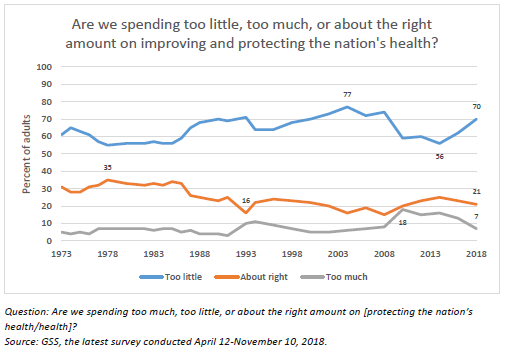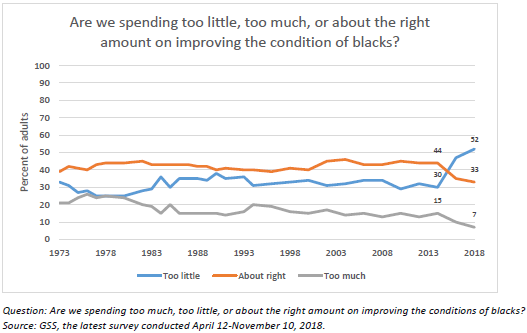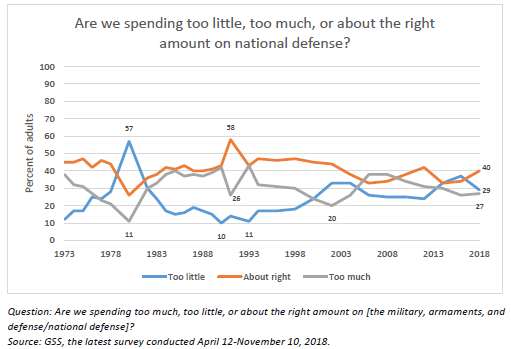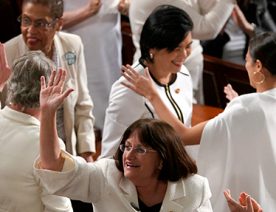
Improving the nation’s education system, providing assistance to the poor, and improving the nation’s health top a long list of public policy issues that Americans say the government is spending too little on, while almost half of Americans say the government is overspending on foreign aid.
This collaborative analysis by The AP-NORC Center and the GSS staff using the 2018 General Social Survey reveals that few Americans are satisfied with the amount of money the government is devoting to a wide range of public policy issues—from local and other domestic issues such as assistance to the poor, dealing with drug addiction, and mass transportation, to global issues such as foreign aid and space exploration.
The General Social Survey (GSS) has been asking Americans their views on the government’s spending on key issues of the day since 1973. For some spending priorities, such as spending on parks and recreation and scientific research, attitudes have remained relatively stable over time. For others, such as military spending, there have been large shifts in attitudes over the past 40 years. Still others, such as improving the conditions of blacks and fighting drug addiction, have seen significant shifts in attitudes in recent years.
Three-quarters say the government is spending too little on education in the U.S., and 7 in 10 say the government is spending too little on assistance to the poor, improving the nation’s health, and dealing with drug addiction. Parks and recreation is the only spending category that a majority of Americans, 58 percent, are satisfied with.

Since 1973, more than half of Americans have said that the United States is spending too little on health and improving and protecting the nation’s health. The percentage peaked in 2004, when 77 percent of Americans said we’re spending too little, and then steadily declined to 56 percent in 2014. Since 2014, the percentage of Americans who say we’re spending too little has been on the rise, climbing to 62 percent in 2016 and 70 percent in 2018.

Attitudes about spending to combat drug addiction peaked in 1989, when 70 percent said the government spends too little. After nearly two decades of stable opinions, the percentage who say we’re spending too little has been steadily increasing from 53 percent in 2012 to 69 percent in 2018.

Attitudes about spending to improve the conditions of blacks have remained relatively stable until recently. On average, from 1973-2014, 31 percent of Americans said that we’re spending too little on improving the conditions of blacks in the United States. In 2016, that number jumped 16 percentage points to 47 percent. In 2018, for the first time, a majority of Americans say we’re spending too little on improving the conditions of blacks.

Attitudes toward military spending have shifted over the past 45 years. A majority of Americans said that the United States spent too little on the military in only one year, 1980. The year the Gulf War ended, 1991, was the only year a majority of Americans said that military spending was about right. In 2018, Americans are more likely to say spending is about right, though the percent of Americans who say we’re spending too little declined 8 percentage points from 37 in 2016 to 29 percent in 2018.

Partisanship affects attitudes toward government spending for most issues in predictable ways—Democrats believe we’re spending too little while Republicans say we’re spending too much. One area where Democrats and Republicans tend to agree is on government spending on infrastructure. In 2018, 53 percent of Democrats, 56 percent of Republicans, and 45 percent of independents say the government is spending too little on highways and bridges.

General Social Survey Description:
The General Social Survey (GSS) is administered by NORC at the University of Chicago, primarily using in-person interviewing. The GSS started in 1972 and completed its 32nd round in 2018. For the last 40 years, the GSS has been monitoring societal change and the growing complexity of American society. The GSS is the largest project funded by the Sociology Program of the National Science Foundation. The typical sample size was 1,500 prior to 1994, but increased to 2,700-3,000 until 2008 and then decreased to 2,000-2,500 for the most recent surveys. Resulting margins of error are between +/- 3.1 for the smaller sample sizes and +/- 2.2 percentage points for the larger sample sizes at the 95 percent confidence level. The GSS 1972-2018 Cumulative File was utilized to produce the statistics presented.
Link: http://gss.norc.org/



